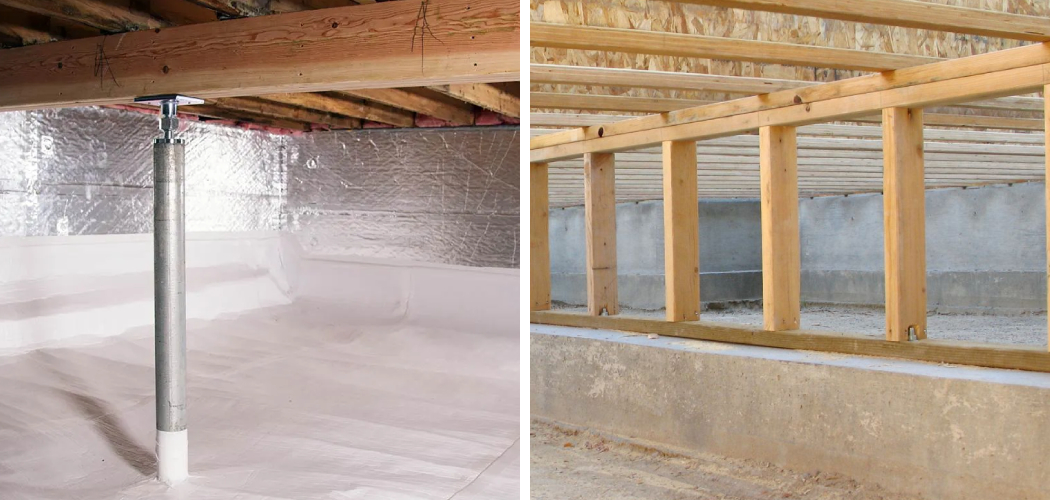Ensuring the stability and integrity of a home’s foundation is paramount, and a crucial aspect of this lies in supporting floor joists in a crawl space. The floor joists, essential for providing structural support to the flooring above, may face challenges such as sagging or weakening over time. In this comprehensive guide, we will delve into the vital methods and techniques on how to support floor joists in a crawl space. From identifying signs of joist issues to implementing proper reinforcements, this guide is designed to empower homeowners and DIY enthusiasts with the knowledge necessary to maintain a robust foundation.
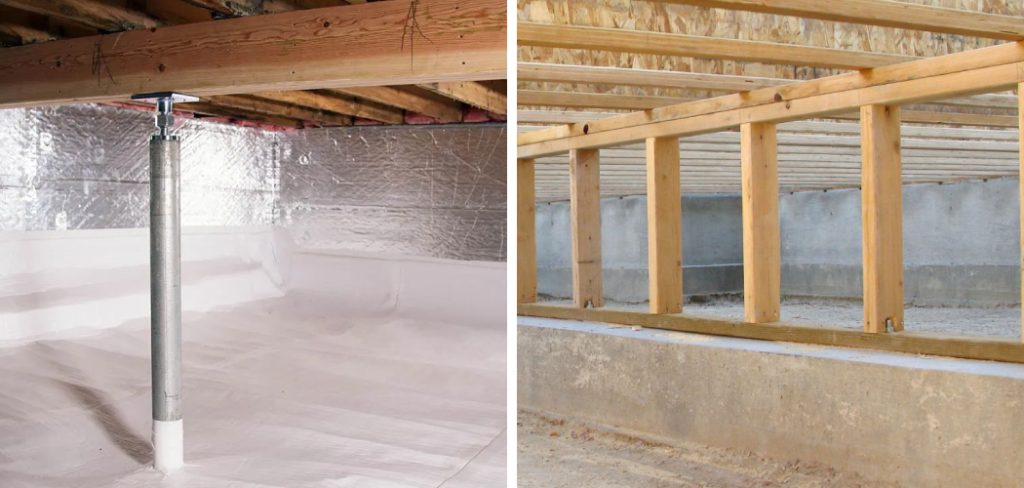
By exploring these methods, you can contribute to the longevity and structural soundness of your home, ensuring a safe and stable living environment for years to come. Let’s embark on the journey to understand and master the art of supporting floor joists in a crawl space.
What are Floor Joists?
Floor joists are integral components of a building’s framework, critical for providing adequate structural support to the floors. Positioned horizontally, these long beams run from one side of the foundation to the other, lying directly beneath the floor surface they support. Typically made from sturdy materials like wood, steel, or engineered wood, joists distribute the weight of people, furniture, and other contents evenly across the floor, preventing excessive sagging or bouncing.
Their proper installation, alignment, and maintenance are vital for the overall stability and integrity of the building, highlighting the importance of understanding their role and ensuring they are adequately supported, especially in areas like crawl spaces where accessibility and visibility are limited.
Functions of Floor Joists in Supporting Floors
Floor joists serve several fundamental roles in the construction and support of a building’s floors. First and foremost, they act as a structural backbone, providing the primary support that floors need to bear the weight of furniture, appliances, and inhabitants. By spanning the width of a building and effectively distributing weight across the surface, floor joists prevent floors from sagging, warping, or collapsing under pressure. Additionally, they contribute to the overall rigidity and stability of a building, helping to maintain a level and sound structure.
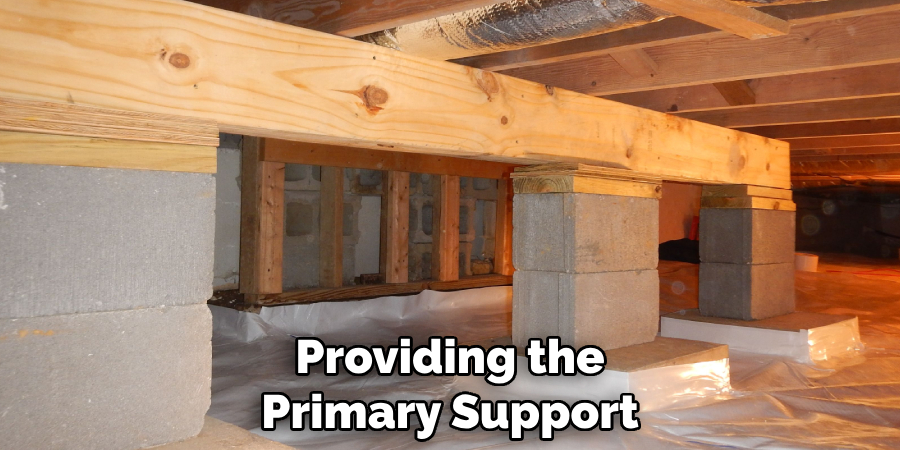
Joists also create a uniform surface for laying down flooring materials, whether it’s hardwood, carpet, or tile, ensuring a smooth and even finish. Furthermore, in crawl spaces and basements, the spacing and arrangement of floor joists allow for the installation of insulation, plumbing, and electrical systems, facilitating accessible maintenance and upgrades. Understanding these critical functions underscores the importance of maintaining and supporting the floor joists, particularly in areas prone to moisture or structural stress.
Importance of Floor Joists in Supporting Floors
The importance of floor joists in maintaining the structural integrity of a building cannot be overstated. They are not merely elements of construction but vital components that ensure the safety, durability, and comfort of a home. Without properly supported and maintained floor joists, floors can become uneven, leading to potential hazards and unwelcome stresses on other parts of the building’s structure. In places like crawl spaces, where external factors such as moisture and soil shifting are prevalent, floor joists are susceptible to deterioration.
Such challenges underscore the necessity of regular inspection and maintenance to prevent weakening, rot, or pest damage. Reinforcing floor joists in these conditions not only extends the lifespan of a building but also protects its inhabitants by ensuring a safe living environment. Furthermore, well-supported floor joists contribute significantly to the aesthetic and functional quality of the floors, providing a strong, stable base for various floor finishes and withstanding the daily demands of household activities.
Characteristics of Crawl Spaces in Residential Buildings
Crawl spaces in residential buildings are typically narrow areas located beneath the ground floor, designed to provide access to wiring, plumbing, and other utilities while also facilitating air circulation beneath the home. These spaces can vary significantly in size, but generally, they are tall enough to allow an individual to crawl, hence the name. The environmental conditions within crawl spaces can be harsh, with humidity levels and moisture being particularly high in many regions.
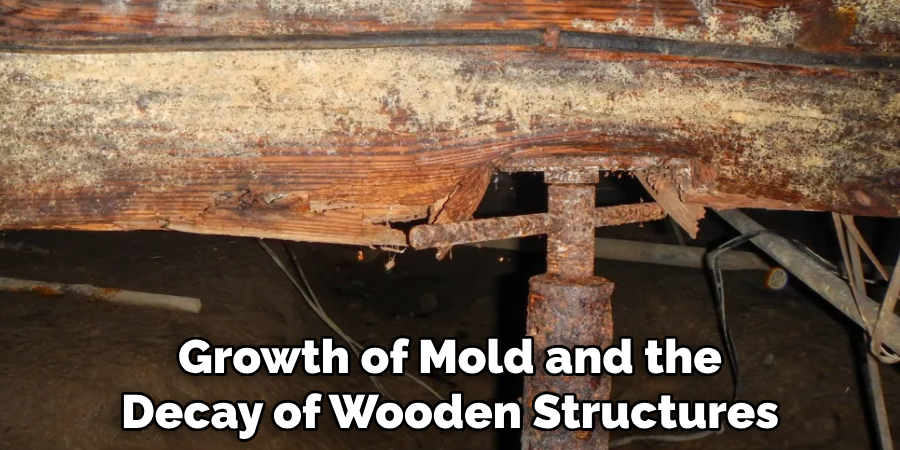
This environment can encourage the growth of mold and the decay of wooden structures, including floor joists which are crucial for the home’s stability. Additionally, crawl spaces are often the site of pest infestations, which can further damage the structural components of a building. Properly managing these spaces—through measures such as ventilation, insulation, and moisture control—is essential for maintaining the integrity and longevity of the building’s structure.
Challenges of Crawl Spaces in Residential Buildings
Crawl spaces, while beneficial for utility access and ventilation, present unique challenges that can significantly impact the structural integrity of residential buildings. The primary issues stem from moisture and humidity, which can lead to the deterioration of wooden floor joists and attract pests that damage the structure. Moisture in crawl spaces often results from poor drainage or inadequate waterproofing, leading to standing water and a damp environment conducive to mold growth and wood rot.
This not only compromises the strength of the floor joists but also affects indoor air quality, potentially causing health problems for the inhabitants. Furthermore, crawl spaces are attractive habitats for pests such as termites and rodents, which can further damage wooden structures and insulation. Another challenge is inadequate insulation and ventilation, which can lead to energy inefficiencies, making homes harder to heat in the winter and cool in the summer.
Managing these challenges requires a comprehensive approach to crawl space maintenance, including proper waterproofing, ventilation, insulation, and pest control. Addressing these issues is crucial not only for the longevity of the building’s structure but also for ensuring a healthy living environment.
Assessing the Condition of Floor Joists
To ensure the structural integrity and safety of a building, regular assessment of the condition of floor joists is critical. Such assessments are aimed at identifying signs of wear, damage, or deterioration that could compromise the building’s stability. When evaluating floor joists, particularly in crawl spaces, three primary factors should be considered: visual signs of damage, the presence of moisture or mold, and evidence of pest infestations.
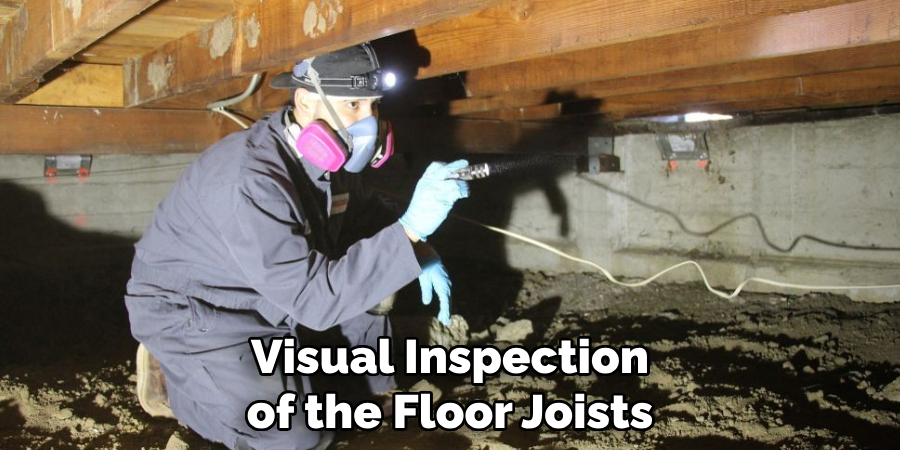
- Visual Inspection: The initial step involves a thorough visual inspection of the floor joists. This includes looking for cracks, splits, or warping that may indicate stress or structural failure. Sagging sections or joists that appear to be pulling away from their fastenings are also red flags.
- Moisture and Mold: Given the susceptibility of wood to water damage, checking for signs of moisture, such as damp spots, staining, or the presence of mold, is essential. Moisture meters can provide a quantitative measure of the moisture content in wood, offering a more precise indication of potential problems.
- Pest Infestations: Inspect for any signs of pests, such as termites or rodents, which can weaken wooden structures by creating tunnels or gnawing. Evidence may include droppings, nests, or the pests themselves.
Addressing issues promptly after detection is crucial to avoiding more severe damage and costly repairs. In some cases, professional evaluation and remediation may be necessary to ensure the floor joists and, by extension, the building’s overall safety and stability.
10 Methods How to Support Floor Joists in A Crawl Space
1. Identify Signs of Joist Issues:
Before implementing support measures, it’s crucial to identify signs of floor joist problems. Look for sagging floors, uneven surfaces, or visible cracks. A careful inspection will help you determine the extent of the issue and the appropriate support methods. Though minor issues can be fixed with simple solutions, it’s best to consult a professional for major problems. Make sure to also check for signs of rot or termite damage, as this can greatly affect the structural integrity of your floor joists.
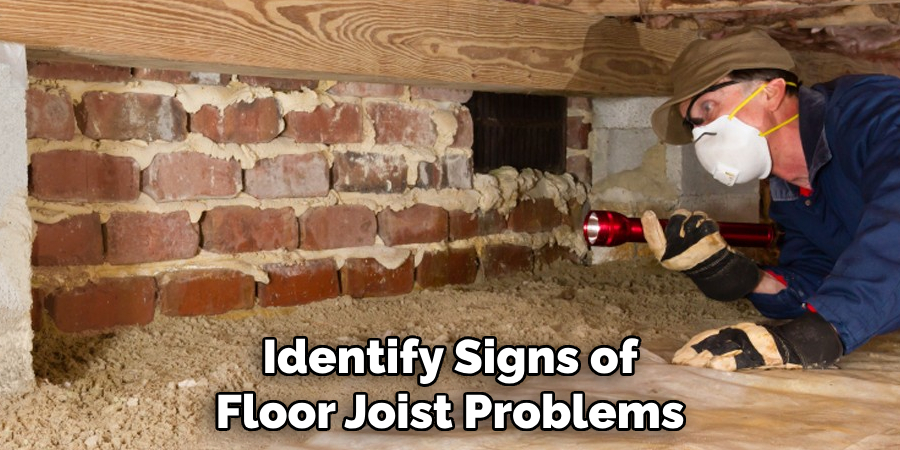
2. Install Adjustable Steel Columns (Jack Posts):
Adjustable steel columns, also known as jack posts, are effective in providing additional support to sagging floor joists. Place them strategically in the crawl space, directly beneath the affected areas. Ensure the columns are set on stable footing and adjusted to support the joists properly.
Using adjustable steel columns, or jack posts, can significantly improve the stability of your home’s structure. These columns are designed to bear heavy loads and provide additional support to sagging floor joists. They are commonly used in crawl spaces, basements, and even attics. If you notice any signs of sagging floors, such as uneven or bouncy walking surfaces, it is important to install adjustable steel columns as soon as possible.
When installing adjustable steel columns, the first step is to determine where they are needed. This can be done by inspecting the crawl space and identifying areas where the floor joists are visibly sagging or uneven. It is important to place the columns directly beneath these areas to provide the most support.
3. Add Cross Bridging for Lateral Support:
Install cross bridging between floor joists to enhance lateral stability. This involves placing perpendicular braces between the joists, preventing them from twisting or shifting. Cross bridging helps distribute loads evenly and reduces the risk of sagging. Additionally, it can also improve the overall strength and durability of the floor system.
Cross bridging is typically made of metal or wood and comes in various shapes and sizes. It can be easily installed by simply nailing or screwing them into place between the joists. Make sure to space them evenly, with no more than 8 feet apart for maximum support.
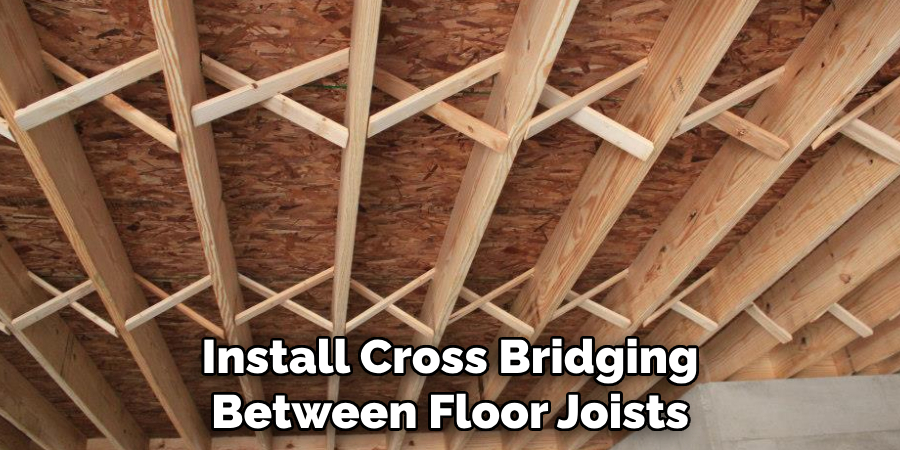
In addition to improving lateral support, cross bridging can also reduce noise and vibrations in the floor system. This is especially beneficial for multi-story buildings or homes with heavy foot traffic on upper floors.
4. Use Solid Blocking:
Solid blocking involves adding wooden blocks between adjacent floor joists. This method enhances load distribution and minimizes joist movement. Install solid blocking at regular intervals, especially in areas where joists show signs of weakness or sagging. Additionally, solid blocking can be used to prevent squeaky floors by filling in gaps between joists and subflooring. This technique is especially useful when hardwood flooring is being installed as it helps in creating a more stable foundation.
Solid blocking can also be used for soundproofing purposes. By adding more layers of solid blocking, the transfer of sound between floors can be reduced. This is particularly beneficial in multi-story buildings where noise from one floor can easily travel to another. Soundproofing with solid blocking can also help create a more comfortable and peaceful living environment.
In addition to its practical benefits, solid blocking can also add structural support to the floor system. By connecting adjacent joists, it helps distribute the weight of heavy furniture or appliances evenly across the floor, preventing any potential damage or collapse.
5. Reinforce with Plywood or OSB:
Apply plywood or oriented strand board (OSB) to the underside of the floor joists. This additional layer reinforces the structural integrity of the joists and helps distribute loads more evenly. Ensure the plywood or OSB is securely attached to each joist.
Adding additional layers of plywood or OSB to the underside of floor joists is a common way to reinforce the structural strength of a building. This method is particularly useful for older structures that may have weakened over time, as well as for new construction projects where extra support is desired.

Plywood and OSB are both types of engineered wood products that are strong and durable, making them ideal for use in floor reinforcement. Plywood is made up of thin layers of wood veneer that are glued together and pressed to form a strong sheet. OSB, on the other hand, is made from strands of wood that are compressed and bonded with resin.
6. Employ Sistering Technique:
Sistering involves attaching new joists alongside the existing ones to provide additional strength. Use construction adhesive and fasteners to secure the new joists to the old ones. This method is effective for addressing localized sagging or weakening of individual joists. In addition, sistering can also be used to reinforce the joists in case of heavy loads or structural changes. This technique is commonly used in old houses where the original joists may not have enough strength to support modern building codes.
Sistering is an effective solution for reinforcing weakened joists or addressing localized sagging. However, it is important to make sure that the new joists are properly attached to the existing ones, and that they are of the same size and type. It is recommended to consult a structural engineer before using this technique to ensure that it is appropriate for the specific situation.
In addition, sistering can also be used as a preventive measure by installing extra joists in areas where heavy loads may occur, such as near staircases or walls. This can help distribute the weight more evenly and prevent potential structural issues in the future.
7. Check and Repair Foundation Supports:
Inspect and, if necessary, repair existing foundation supports in the crawl space. Ensure that piers and footings are stable and properly positioned. Reinforce or replace any deteriorated supports to prevent further settling of the foundation.
8. Adjust Moisture Levels:
Moisture can contribute to the deterioration of wooden joists. Use a vapor barrier to control moisture levels in the crawl space. Proper ventilation and the installation of a dehumidifier can help maintain an environment that is less conducive to wood decay. Additionally, make sure to fix any leaks or plumbing issues that may be causing excess moisture in the crawl space.
Another important factor to consider is the grading around your home. Improper grading can cause water to collect and pool near the foundation of your home, leading to increased moisture levels in the crawl space. Make sure your yard slopes away from your house and that gutters are properly installed and functioning to direct water away from the foundation.
9. Consult a Structural Engineer:
If the floor joist issues are extensive or if you are uncertain about the appropriate measures to take, consult a structural engineer. A professional assessment can provide specific recommendations tailored to the unique characteristics of your home. A structural engineer can also help determine if the issue is caused by a larger underlying problem, such as foundation issues or improper construction.
10. Reinforce Crawl Space Beams:
Crawl space beams support the floor joists, and reinforcing them can significantly enhance structural stability. Use additional beams or steel reinforcements to support existing beams, ensuring they can effectively carry the load of the floor above.
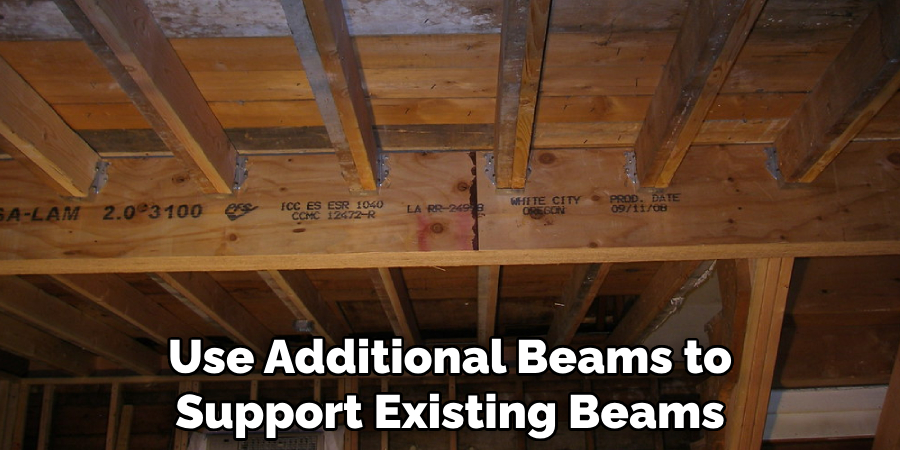
Conclusion
In conclusion, ensuring adequate support for floor joists in a crawl space is essential for maintaining the structural integrity and safety of a building. By understanding the role of floor joists and recognizing signs of potential issues, homeowners can take proactive measures to address support needs effectively. Whether through the installation of adjustable steel columns, concrete piers, or wood blocking, choosing appropriate support methods tailored to the specific requirements of the structure is paramount.
Additionally, implementing cross-bracing and addressing moisture and ventilation concerns further enhances stability and longevity. While some aspects of floor joist support may require professional expertise, regular maintenance and monitoring play a crucial role in preventing future problems and preserving the integrity of the crawl space. Hopefully, this article gave you some helpful tips about how to support floor joists in a crawl space successfully, so now that you have the proper knowledge on how to get the job done, why not give it a try today?
